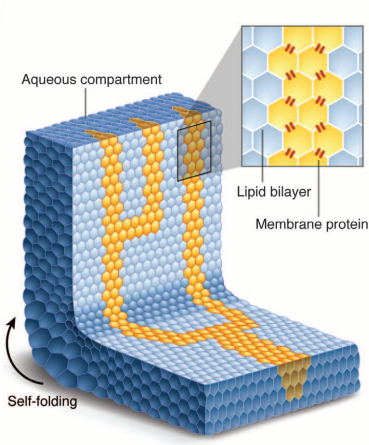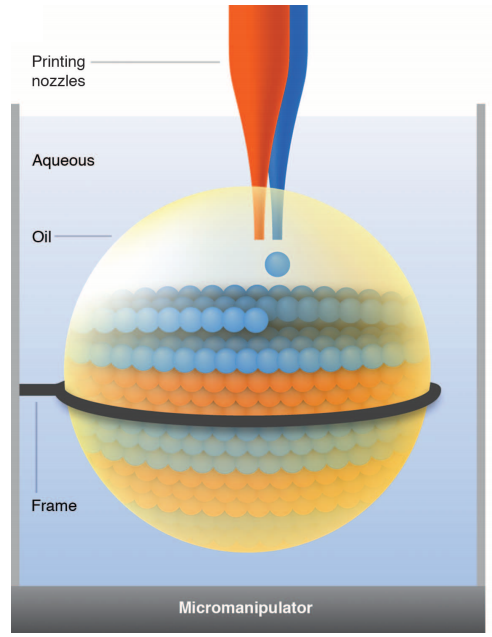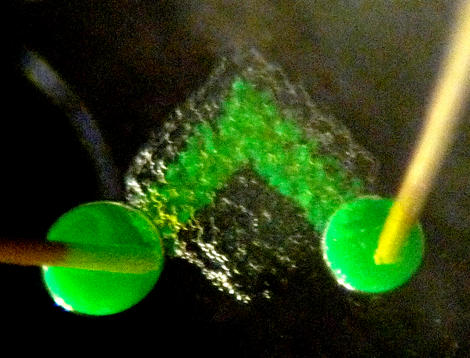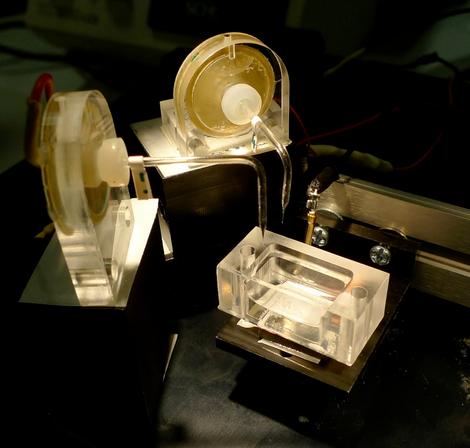3D-printing synthetic tissues
April 9, 2013

Illustration of a printed droplet network
A custom-built programmable 3D printer can create materials with some the properties of living tissues, Oxford University scientists have demonstrated.
The new type of material consists of tens of thousands of picoliter connected water droplets encapsulated within lipid films, which can perform some of the functions of the cells inside our bodies.
These printed “droplet networks” might be interfaced with tissues, used as tissue engineering substrates, or developed as mimics of living tissue.
The droplet networks could be the building blocks of a new kind of technology for delivering drugs to places where they are needed, and potentially could one day replace or interface with damaged human tissues.
The droplet networks are entirely synthetic, so they avoid some of the problems associated with other approaches to creating artificial tissues, such as those that use stem cells.

Printing process: aqueous droplets are ejected into a drop of oil suspended in aqueous solution.
The team reports their findings in Science.
Each droplet is an aqueous compartment about 50 microns in diameter. That’s about five times larger than living cells, but the researchers believe there is no reason why they could not be made smaller.
The networks remain stable for weeks.
“Conventional 3D printers aren’t up to the job of creating these droplet networks, so we custom-built one in our Oxford lab to do it,” said Bayley.
“At the moment, we’ve created networks of up to 35,000 droplets but the size of network we can make is really only limited by time and money.
For our experiments, we used two different types of droplet, but there’s no reason why you couldn’t use 50 or more different kinds.”
“We aren’t trying to make materials that faithfully resemble tissues, but rather structures that can carry out the functions of tissues,” said Professor Hagan Bayley of Oxford University’s Department of Chemistry, who led the research.
“We’ve shown that it is possible to create networks of tens of thousands of connected droplets. The droplets can be printed with protein pores to form pathways through the network that mimic nerves and are able to transmit electrical signals from one side of a network to the other.”
The droplet networks can be designed to fold themselves into different shapes after printing. The folding, which resembles muscle movement, is powered by osmolarity differences that generate water transfer between droplets.
The printed structures could in principle employ much of the biological machinery that enables the sophisticated behavior of living cells and tissues, the researchers suggest.

Photograph of a printed network with an aHL protein (green) that acts as an electrically conductive pathway, with electrodes placed at the ends of the conductive pathway.
More sophisticated networks might be interfaced with failing tissues to
support their functions.
Alternatively, cells could be included inside the droplets during printing
for various applications, such as to immobilize cells within a defined 3D dimensional scaffold for tissue engineering.
(Credit for all images: G Villar/Oxford University)
